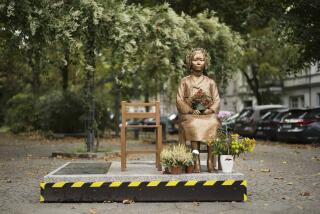Germans Mark Horrors of Nazi Genocide Plot
- Share via
BERLIN — In an elegant lakeside villa framed by frosted shrubbery and falling snow, 15 high-ranking Nazis sorted out the bureaucratic details for exterminating Europe’s 11 million Jews. As the conference invitations had promised, luncheon followed.
It took only 90 minutes for Adolf Hitler’s henchmen to transform the scattered arrangements for his “final solution” into a state-run program for mass deportations and indiscriminate slaughter--the Wannsee Protocol--on that snowy Tuesday 60 years ago today.
The Wannsee Conference, named after the lake on which the villa is situated, was a watershed event in Third Reich history because it elevated the unspoken plot to annihilate European Jewry into the machinery of the state.
The 15 participants, all later killed or imprisoned except for the fugitive Heinrich Mueller, of whom no trace was found, were chosen by host Reinhard Heydrich for the broad swath of expertise and resources they commanded. They were deputy ministers for police, security, justice and planning. They were the ones who could put ideas into action. Three years and one bloody springtime later, 6 million Jews had been slaughtered.
With the passage of 60 years and extensive academic research and remorseful reflection, Germans have come to see Wannsee as a tragic milestone because of the passive acceptance of mass murder apparent among the protocol’s authors.
“There has never been a bleaker rendition of the orderly governance of murder,” British historian Mark Roseman writes in a newly released account of the conference, “The Villa, the Lake, the Meeting: Wannsee and the Final Solution.” “To this day the Wannsee Protocol remains the most emblematic and programmatic statement of the Nazi way of doing genocide.”
Today’s anniversary is being observed here with memorial events throughout the city and the first extensive exhibition on the Holocaust at the German Historical Museum. Like the Wannsee villa display, it attempts to explain how Germans’ World War II hardship helped fuel an acceptance of state anti-Semitism.
The date is also rekindling Germany’s recurring debate over the culture of memory, a mostly one-sided discussion of how much guilt and responsibility should still encumber a nation where many of the perpetrators have long since died.
Not a murmur of dissent was mentioned in the 15 pages of minutes from the meeting taken down by Adolf Eichmann, the Nazi security chief and expert on the “Jewish question.” There were conflicting views about where to start and how much to invest in keeping alive some of the doomed long enough to build their own prisons, but on the big picture the architects of genocide were all on the same page.
“The meeting was conducted quietly and with much courtesy, with much friendliness. There was not much speaking, and it did not last a long time. The waiters served cognac, and in this way it ended,” Eichmann recalled during his 1961 trial in Israel, where he was executed a year later.
The smudged, faded pages of the protocol include guidance to government offices for the “evacuation” of Jews and instructions for determining the fate of those of mixed background. One neatly aligned table totes up the number of Jews in each of the 31 countries and occupied regions and concludes that more than 11 million Europeans were in need of extermination.
More a secret code of policies than actual marching orders, the protocol left itself open to amendment, allowing the Nazis to later add homosexuals, Communists, the mentally and physically disabled and Gypsies such as the Sinti and the Roma to the list of authorized victims.
Chancellor Gerhard Schroeder, an unwavering voice for the majority opinion here that those who fail to dwell on the crimes of the past are destined to repeat them, again spoke for his fellow Germans in a formal statement issued to coincide with the anniversary.
“It clarified the whole perversion of the Nazi system and served as unique documentation of the breakdown of civilization that even today leaves us speechless,” Schroeder said of Wannsee. “The more time distances us from these events, the more urgent is our task to ensure that the remembrances of these crimes against humanity are preserved and unfalsified so they can be passed from generation to generation.”
Wannsee’s significance to a historical perspective on the Holocaust was a long time coming to the consciousness of Germans. In the mid-1960s, a survivor of the Auschwitz concentration camp, Joseph Wulf, tried with the help of the World Jewish Congress to acquire the villa and turn it into a memorial and education center. But Klaus Schuetz, then mayor of West Berlin and empowered to veto such projects, did so on the grounds that Wulf’s proposal was “macabre.”
The villa, which was acquired by the Nazi Party in 1940 for use as a retreat by senior officers, was used by Soviet troops after the Third Reich’s defeat in 1945, then by U.S. officers and later as a vocational school in what was, until reunification in 1990, the southwestern extreme of divided Berlin. Not until the 50th anniversary of the conference, Jan. 20, 1992, was the villa opened as a memorial and documentation center. More than 500,000 people have since visited the site.
“German historians were extremely slow in turning their attention to the National Socialist era because many of them were compromised by their own past deeds,” the daily Sueddeutsche Zeitung commented Saturday.
Writing in Saturday’s Frankfurter Allgemeine Zeitung, Holocaust historian Goetz Aly suggested that the significance of the Wannsee gathering was the cool precision with which genocide was broken down into civil servants’ assignments. Germans’ methodology discloses a lot, he implied with the observation that tiny, Nazi-occupied Denmark was able to thwart Berlin’s orders for deportation of its Jews while citizens in the homeland of the Holocaust’s inventors put up no resistance.
“The biggest open questions remaining about the Wannsee Conference are clear: What did the Germans know? What did they want to know?” Aly asked. “To what extent were they hardened by war, the bombings and their daily concerns? What did they feel, and how natural did it seem for them to profit from deportation?”
The Wannsee meeting’s minutes show that the participants saw ways of easing the housing shortages in bombed northern cities by dispossessing Jews and of rewarding self-sacrificing Germans with the food and fuel still being, in the conferees’ view, wasted on the doomed Jews already in camps and prisons.
Host Heydrich even had a strategy for guarding against public sympathies being stirred up over the campaign of extermination: Old Jews with the venerable status of having fought for Germany during World War I were spared the gas chambers and sent off instead to the Theresienstadt ghetto for artists, veterans and other elites.
Thus, Heydrich noted, would those making a reality of Hitler’s plot to annihilate the Jews remove the need for humanitarian “interventions.”
More to Read
Sign up for Essential California
The most important California stories and recommendations in your inbox every morning.
You may occasionally receive promotional content from the Los Angeles Times.











